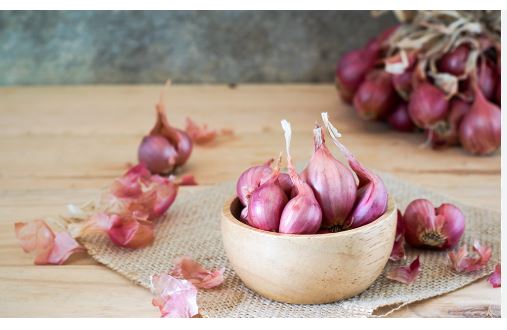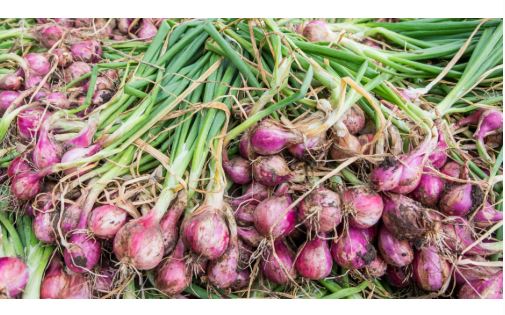
Shallots are a culinary gem, bridging the gap between onions and garlic with their distinctive flavor profile. They grow in clusters, forming multiple bulbs that range in size and hue, offering a subtler, more refined taste than their relatives. Their versatility makes them a staple in kitchens worldwide, enhancing everything from sauces to roasts.
The bulbs are typically encased in thin, papery skin that peels away to reveal firm, aromatic flesh. This outer layer varies in color, while the interior often carries faint tinges that hint at their potency. Their texture—crisp yet tender—holds up well in both raw and cooked preparations, adding depth without overwhelming.
Flavor-wise, shallots strike a balance: milder than onions, with a touch of garlic’s sharpness, often underscored by a natural sweetness. This complexity shines when sautéed or caramelized, unlocking richer notes, though they’re equally prized raw in dressings or as a garnish. Their taste adapts to the dish, making them endlessly adaptable.
In the garden, shallots are hardy and relatively quick to mature, thriving in well-drained soil under full sun. They’re planted as sets or seeds, yielding clusters that multiply from a single bulb. Harvested when tops yellow, they store well, extending their usefulness long after picking.
Culturally, shallots hold a special place, especially in cuisines that value nuanced seasoning. They’re celebrated for elevating simple ingredients into something extraordinary, a quiet workhorse in the pantry. Whether in a rustic stew or a delicate vinaigrette, they bring sophistication with minimal fuss.

Varieties of Shallots
French Gray Shallot (Griselle)
Often hailed as the “true shallot” by purists, the French Gray, or Griselle, boasts an elongated, pear-shaped bulb encased in thick, grayish-brown skin that peels away to reveal purplish-white flesh. Its flavor is robust—more intense than other varieties—with a pronounced pungency that softens into a rich, complex taste when cooked. Smaller than many shallots, it typically measures 1 to 1.5 inches long. Originating in France, it’s a favorite among chefs for gourmet dishes like sauces or roasts. It matures in about 200 days, requiring a longer growing season, and stores well for 6 to 7 months in cool, dry conditions.
Jersey Shallot (Pink Shallot)
The Jersey Shallot, also called the Pink Shallot, is the most common variety found in U.S. and European grocery stores. Its bulbs are larger and rounder than the French Gray, with glossy, rose-pink to coppery skin and pale pinkish-purple flesh. The flavor is milder and sweeter than its gray cousin, making it versatile for raw uses like salads or cooked in stews. It matures in about 100 days and thrives in a variety of soils, which contributes to its widespread cultivation. Storage life is decent—up to 2 months at room temperature or 3 to 6 months refrigerated.
Banana Shallot (Echalion)
A hybrid of shallots and onions, the Banana Shallot earns its name from its long, slender, slightly curved shape, often 3 to 4 inches in length. Its skin is a rust-brown or golden hue, easy to peel, revealing creamy white flesh with a subtle magenta tint. The taste leans sweeter than traditional shallots, with a mild onion-like quality, ideal for roasting or caramelizing to enhance its natural sugars. Developed in England, it matures in 90 to 100 days and stores for 3 to 6 months in cool conditions.
Prisma Shallot
The Prisma Shallot is instantly recognizable by its deep, glossy red skin—both inside and out—giving it a striking appearance. This hybrid variety has a teardrop shape and a firm texture, with a strong, pungent flavor that rivals onions, though it mellows when cooked. It’s a fast grower, reaching maturity in about 100 days, and its ease of cultivation makes it a grocery store staple. The flesh is crisp, with a reddish hue, perfect for pickling or adding bold flavor to soups. It stores well for up to 6 months, retaining its vibrancy and taste.
Pikant Shallot
A French heirloom, the Pikant Shallot features mahogany-brown skin and reddish-pink flesh, offering a potent, spicy flavor that’s sharper than most shallots. Its bulbs are small to medium, about 1.5 to 2 inches, with a slightly elongated form. It matures quickly—around 80 days—making it one of the fastest-growing varieties, though its storage life is shorter, lasting about a month at room temperature. Prized in French cuisine, it’s excellent in vinaigrettes or sautéed dishes where its intensity can shine without overpowering.
Dutch Yellow Shallot
The Dutch Yellow Shallot sports a golden-tan, papery skin that encases creamy white flesh with faint green tinges. Its flavor is milder and sweeter than red varieties, with a gentle onion undertone, making it a go-to for soups, stews, or raw garnishes. The bulbs are rounder and slightly larger, often 2 to 2.5 inches in diameter, and grow in tight clusters. It’s a hardy variety, maturing in 90 to 100 days, and excels in storage—lasting over a year if kept cool and dry.
Ambition Shallot
A hybrid French variety, the Ambition Shallot has a teardrop shape with reddish-copper skin and creamy white flesh faintly streaked with purple. It delivers a balanced flavor—mild yet assertive—suitable for both raw and cooked applications. Larger than many heirlooms, its bulbs reach 2 to 3 inches and mature in about 100 days. Known for exceptional storage (up to 6 months), it’s a reliable choice for growers seeking high yields and durability. Its subtle fragrance enhances dishes like quiches or roasted vegetables.
Longor Shallot
Another French classic, the Longor Shallot mirrors the Banana Shallot with its elongated, cylindrical form—often 3 to 4 inches long—and tough, red-copper skin. Its pinkish-white flesh carries a slightly stronger taste than half-long varieties, with a fruity note that deepens when cooked. It matures in 90 to 100 days and suits short-term storage (about 3 months). Popular in France, it’s often roasted whole or used in rich sauces, where its shape and flavor add elegance to the plate.
Matador Shallot
The Matador Shallot is a hybrid known for its uniform, medium-sized bulbs—about 1.5 to 2 inches in diameter—wrapped in glossy, reddish-brown skin. Its flesh is white with a faint purple blush, delivering a balanced flavor: mildly pungent with a sweet finish. Maturing in roughly 95 days, it’s a reliable producer with high yields, favored by commercial growers. It stores exceptionally well, up to 8 months in cool, dry conditions, and its firm texture makes it ideal for slicing into salads or caramelizing for a rich depth in sauces.
Sante Shallot
Sante Shallots stand out with their round, plump bulbs and thick, golden-brown skin that peels easily to reveal creamy white flesh with a subtle green ring. The flavor is robust yet smooth, leaning toward onion-like sharpness with a hint of sweetness when cooked. This variety matures in 100 to 110 days and thrives in cooler climates, making it popular in northern Europe. It stores for 6 to 7 months and shines in hearty dishes like stews or roasted alongside meats, where its bold taste holds up.
Topper Shallot
The Topper Shallot, a Dutch hybrid, features small, elongated bulbs—around 1 to 1.5 inches long—with coppery-tan skin and pale pinkish-white flesh. Its taste is delicate and slightly nutty, less intense than red varieties, making it perfect for raw uses like dressings or as a garnish. It’s a quick grower, ready in 85 to 90 days, and offers moderate storage of about 4 months. Its compact size and mildness appeal to home cooks who prefer subtlety over sharpness.
Golden Gourmet Shallot
Golden Gourmet Shallots are prized for their bright, golden-yellow skin and plump, round bulbs, typically 2 to 2.5 inches across. The flesh is creamy white with a faint yellow tint, offering a sweet, mellow flavor with minimal bite—ideal for roasting or sautéing to enhance its natural sugars. This variety matures in 90 to 100 days and is a favorite among gardeners for its disease resistance and high yields. It stores impressively, lasting up to 10 months, making it a practical choice for long-term use.
Red Sun Shallot
Red Sun Shallots are striking with their deep reddish-purple skin and matching interior rings, encasing crisp, white flesh. Their flavor is strong and spicy—closer to garlic than onion—softening into a savory richness when cooked. The bulbs are medium-sized, about 1.5 to 2 inches, and pear-shaped, maturing in 100 days. They store well for 6 months and are a bold addition to pickles, stir-fries, or any dish needing a vibrant kick. Their color also makes them a visual standout.
Hative de Niort Shallot
A traditional French variety, Hative de Niort has slender, tapered bulbs with tough, reddish-brown skin and pale pink flesh. Its flavor is intense and aromatic, with a sharp bite that mellows into a warm, earthy taste when sautéed—perfect for classic French sauces like beurre blanc. It matures early, in about 80 to 90 days, and grows well in rich, well-drained soil. Storage lasts around 5 months, and its heritage status makes it a cherished pick for culinary enthusiasts.
Zebrune Shallot
Zebrune, often called the “banana shallot of the South,” is a French heirloom with long, curved bulbs—up to 4 inches—and golden-brown skin streaked with faint white lines, resembling zebra stripes. The flesh is creamy with a pinkish hue, offering a sweet, mild flavor with a fruity undertone. It matures in 90 to 100 days and suits warmer climates. Storage is shorter, about 3 to 4 months, but its elegant shape and taste make it a star in roasting or slicing thinly for delicate dishes.
Mikor Shallot
Mikor Shallots are small and round, rarely exceeding 1.5 inches, with glossy, copper-red skin and firm, white flesh tinged with purple. Their flavor is sharp and peppery, with a lingering aftertaste that softens when cooked, ideal for adding depth to soups or braises. This variety matures quickly—around 85 days—and is bred for uniformity, appealing to growers seeking consistency. It stores for 5 to 6 months and brings a punchy, compact option to the kitchen.